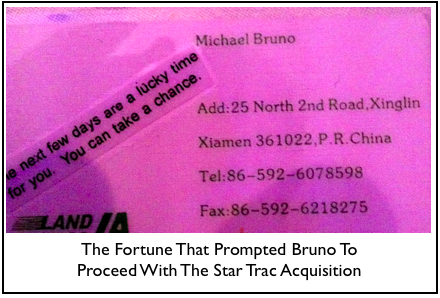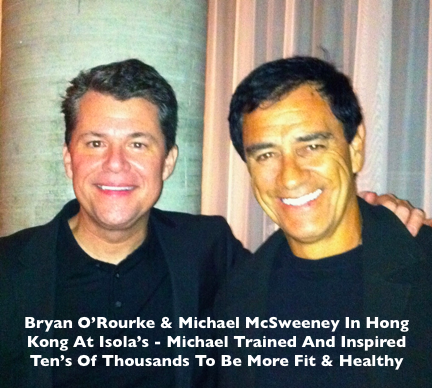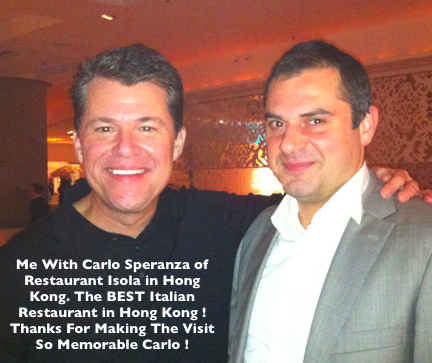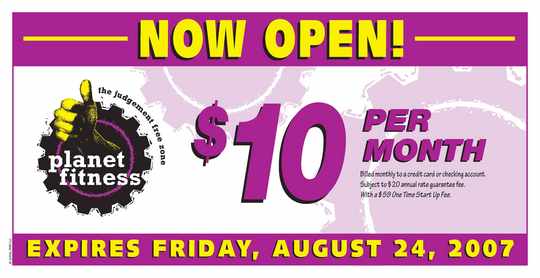 It was a pleasant evening in Chicago at Club Industry last year when an associate asked me to join him for dinner; he wanted to introduce me to someone. At the time I wasn’t certain who I’d be meeting but it turned out to be Michael Bruno, the recent acquirer of Star Trac and as I later discovered a legend in the fitness industry.
It was a pleasant evening in Chicago at Club Industry last year when an associate asked me to join him for dinner; he wanted to introduce me to someone. At the time I wasn’t certain who I’d be meeting but it turned out to be Michael Bruno, the recent acquirer of Star Trac and as I later discovered a legend in the fitness industry.
Early in my career I worked for Al Copeland, the Popeye’s Famous Fried Chicken founder and entrepreneur. He was a self-made, charming, street smart visionary. I had not met many like him before or after my nine year run as one of his key executives, that is until that night in October over dinner at Club Industry. Certain things about Michael reminded me of Al.
“You need to come see my factory in Xiamen”, Michael said to me, after explaining his thinking behind the Star Trac acquisition. I thought it a kind offer, one that some people might extend out of courtesy but not seriously. However, Michael Bruno isn’t “some people”. Months later, after learning of my plans to speak to his business development team, I got an email; “Bryan, I’ll be heading to Xiamen following the Star Trac meeting. Why don’t you tag along ?” True to his word he invited me to China to see his factory, and so in my quest to understand more about the global fitness business, I made the travel arrangements. Little did I know what I would find.
Michael's Company Land America
“Bryan, why don’t you get over to the hotel and clean up?”, Michael asked me after landing in Xiamen following eighteen hours in the air with a quick connection through Hong Kong. “I’m heading to the factory. Call me when your ready and I’ll have you picked up.”
One thing I can say, having spent time with many accomplished business people, is that Michael is one of the most gracious. He proudly tells of his annual company party held at a stadium in Xiamen where thousands of his employees and their families celebrate each year. Michael calls it his birthday party. But today there wasn’t a party, his focus was getting to his factory, a huge nearly million square foot operation that he built from scratch.
I took Michael’s advice and after a shower met him at his offices where he was deeply engaged with his managers and engineers. He was working on innovation for his Star Trac line of cardio and strength equipment and the mantra, which I heard over and over again during my time with he and his team, was “quality”.
 In the deepest and best sense Michael is old school.He believes quality in the long run is the greatest competitive advantage. I recall reading a quote from Power Plate International CEO Gregg Hammann in a Club Industry release. Hammann was the CEO of Nautilus in 2007 when he helped persuade the Nautilus board of directors to buy Land America for $72 million. That deal was terminated after Hammann left Nautilus, and Sherborne Investors took control of the Nautilus board. Here is what Greg shared with CBI:
In the deepest and best sense Michael is old school.He believes quality in the long run is the greatest competitive advantage. I recall reading a quote from Power Plate International CEO Gregg Hammann in a Club Industry release. Hammann was the CEO of Nautilus in 2007 when he helped persuade the Nautilus board of directors to buy Land America for $72 million. That deal was terminated after Hammann left Nautilus, and Sherborne Investors took control of the Nautilus board. Here is what Greg shared with CBI:
“Michael's highly intelligent. He was always a guy that you could have very direct and frank conversations with. Michael doesn't pull punches with people. He's a man of high integrity. He does the right thing for the customer. The more he's involved in the fitness industry, the better it is for all of us. He's a not a public relations CEO. What you're going to see is him do the right thing for the business, the right thing for the industry, the right thing for customers.”
Greg was right and interestingly in January, my friend Stuart Goldman wrote an article, “Nautilus Commercial Buyer Remains A Mystery To The Fitness Industry”. Indeed Michael and his companies were not known to many, except those in the highest posts of the global fitness equipment business.
Few people make lasting impressions on me but as I followed him along on the factory floor I recalled my days with my former boss Al Copeland. Michael knew the names of many of the 1,400 workers in the plant, who greeted him with affection. It became apparent that the man has a deep understanding of all aspects of manufacturing as he personally inspected equipment and queried his team on various procedures and process improvements. The factory employs 90 engineers and applies state of the art manufacturing equipment and practices: from automated robotic welders to intense quality systems (the facility is ISO, ETL, CE, ECI and FDA certified). Strength equipment, treadmills, aircraft components and medical equipment devices, Land America builds them all and has got to be one of the finest manufacturing companies in the world. You have to see it to believe it. Now I knew why he was so proud and now I think I understand what Greg Hammann was talking about.
Like most successful entrepreneurs, Michael knows what he’s doing and it comes from well over twenty years experience. He had a string of business relationships that involved producing for many well known brands - he just didn’t own the brands himself. He was and remains a major manufacturer for Nautilus among others and has been courted by several well known fitness equipment suppliers at one point or another. He more boldly and strategically entered the fitness business by acquiring the StairMaster and Schwinn brands from Nautilus Inc. earlier in 2010. His more recent acquisition of Star Trac was another aggressive move, as Michael had increasingly and strategically upgraded the innovative capabilities of his team over the years, providing him with a unique global position to achieve vertical integration. The hard work seems poised to pay off. Now not only does Michael Bruno make the product, he owns the brands as well.
Star Trac
 When you spend time with a person like Michael, one raised as the son of a police chief in Youngstown, Ohio, whose first job was in the concrete business and ultimately made his way to live in China for over twenty years building a huge company from scratch, you might hear a good story or two. So when we visited about his acquisition of Star Trac Michael asked me, “Have I told you about the fortune cookie?” Apparently, when evaluating the Star Trac opportunity, Michael reached out to speak with Jim Doody, Star Trac’s former CEO and owner. He arranged to meet Jim in San Francisco to discuss a potential transaction. The next day Michael had Dim Sum with his family, whom he took along for the trip. “It was the best Dim Sum I ever had and that's saying something”, Michael said referring to his long history in China. “The funny thing was they brought out these fortune cookies after the meal. Its amazing how good the food was, but ironically there aren’t fortune cookies in China Bryan”, he laughed. Out of his wallet Michael pulled out the fortune, which he keeps laminated to one of his business cards. It said: “The next few days are a lucky time for you. You can take a chance.” With that Michael took the chance and structured the business deal which added another valuable brand, Star Trac, to his portfolio. Indeed, a great story and one of several I was able to hear.
When you spend time with a person like Michael, one raised as the son of a police chief in Youngstown, Ohio, whose first job was in the concrete business and ultimately made his way to live in China for over twenty years building a huge company from scratch, you might hear a good story or two. So when we visited about his acquisition of Star Trac Michael asked me, “Have I told you about the fortune cookie?” Apparently, when evaluating the Star Trac opportunity, Michael reached out to speak with Jim Doody, Star Trac’s former CEO and owner. He arranged to meet Jim in San Francisco to discuss a potential transaction. The next day Michael had Dim Sum with his family, whom he took along for the trip. “It was the best Dim Sum I ever had and that's saying something”, Michael said referring to his long history in China. “The funny thing was they brought out these fortune cookies after the meal. Its amazing how good the food was, but ironically there aren’t fortune cookies in China Bryan”, he laughed. Out of his wallet Michael pulled out the fortune, which he keeps laminated to one of his business cards. It said: “The next few days are a lucky time for you. You can take a chance.” With that Michael took the chance and structured the business deal which added another valuable brand, Star Trac, to his portfolio. Indeed, a great story and one of several I was able to hear.
Star Trac has had a bold and progressive past that hit a speed bump in 2010 under its previous leadership. The business had been undercapitalized and was loosing money amid tough economic times. Michael was one of a few strategic industry players capable of pulling off the deal. Now a lot of work is going into Star Trac’s offering and it is a big focus of the organization. In inspecting the factory and meeting the man who is now behind the business I am thinking that the Star Trac organization has been acquired by someone who can make good on its future. Over dinner in Xiamen one evening watching Michael interact and catch up with his Vice President Luca Tonarini, assistant Leon Chen and friends and associates I felt pretty certain about Star Trac and from what I’ve learned, I’ll pay closer attention to my fortune cookie when I next dine on Chinese.
Please contact me, Bryan O'Rourke, and tell me what you think. I'll be sharing another post on my trip to China later in the week. Thanks for reading and following along !
 Heading back to the U.S. today from China but not before getting to visit with one of the world's great ambassadors of fitness - Michael McSweeney. My partner Robert Dyer, and I have gotten to know Michael over the past few years in our work with Les Mills, which we distribute through Fitmarc in 12 states in the south central U.S.
Heading back to the U.S. today from China but not before getting to visit with one of the world's great ambassadors of fitness - Michael McSweeney. My partner Robert Dyer, and I have gotten to know Michael over the past few years in our work with Les Mills, which we distribute through Fitmarc in 12 states in the south central U.S. PS: I want thank Michael Bruno who contacted Carlo from Isola and insisted McSweeney and I visit him for dinner. Isola is the best Italian restaurant in all of Hong Kong. Thanks again Michael Bruno - Carlo Speranza was terrific and the great fresh Italian food at Isola's in Hong Kong was outstanding !
PS: I want thank Michael Bruno who contacted Carlo from Isola and insisted McSweeney and I visit him for dinner. Isola is the best Italian restaurant in all of Hong Kong. Thanks again Michael Bruno - Carlo Speranza was terrific and the great fresh Italian food at Isola's in Hong Kong was outstanding !













